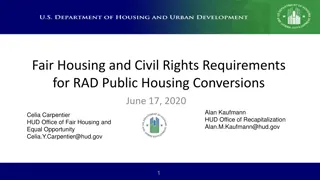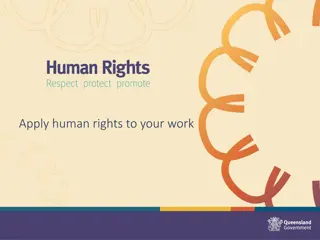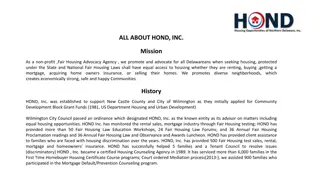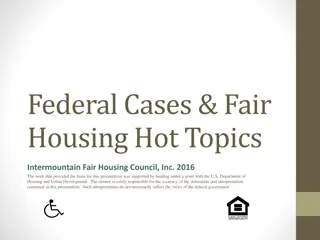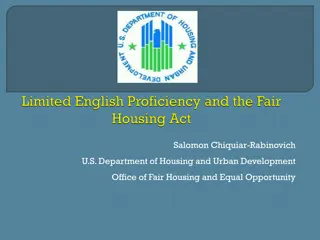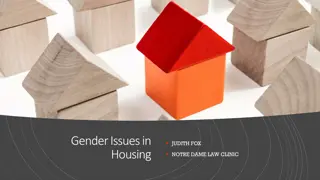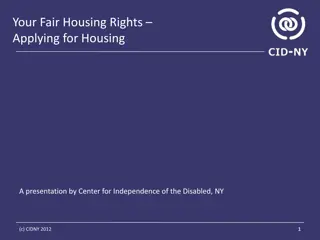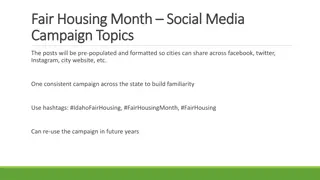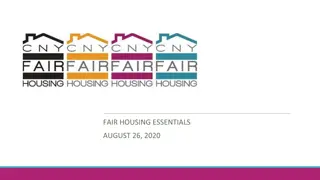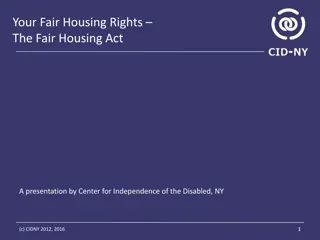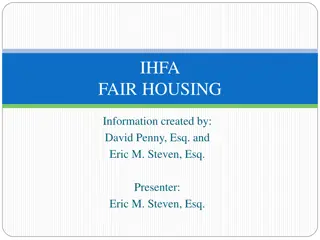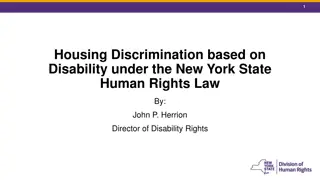Understanding Fair Housing Rights and Responsibilities
Explore the details of Fair Housing Rights and learn about the protected classes under federal, state, and local laws. Understand Familial Status guidelines and who must comply with Fair Housing Laws. Discover exemptions in New York State and the key aspects of compliance in housing provision and residential lending.
Download Presentation

Please find below an Image/Link to download the presentation.
The content on the website is provided AS IS for your information and personal use only. It may not be sold, licensed, or shared on other websites without obtaining consent from the author. Download presentation by click this link. If you encounter any issues during the download, it is possible that the publisher has removed the file from their server.
E N D
Presentation Transcript
About CNY Fair Housing Private, non-profit organization founded in 1991 Conduct around 200 investigations of housing discrimination per year and train around 2,000 people Funded by HUD, Onondaga County, Cities of Syracuse, Utica, Auburn, and Watertown, and through private donations and contractual services
Disclaimer Nothing presented here either verbally or in writing is legal advice. Please consult an attorney for legal advice.
Protected Classes Under Fair Housing Laws Federal Law: Race Color National Origin Religion Sex/Gender Disability Familial Status (families w/children) State Law: Age Marital Status Military Status Sexual Orientation Gender Identity Source of Income Local Laws: Example: height and weight
Familial Status Familial Status: families with children under the age of 18, pregnant women, anyone who has or is trying to obtain custody of minor children (adoption, foster care, grandparents) General guidelines on occupancy standards (local laws may apply): Bedroom for 1 person Greater than 70 square feet Bedroom for 2 or more persons Greater than 50 square feet per person Children under 2 years old do not count in determining occupancy
Who must comply with the law? Anyone involved in the provision of housing and residential lending Includes property owners, housing managers, housing staff, housing associations, lenders, real estate agents, and brokerage services and in some cases, state and local governments
Exemptions in NYS Owner-occupied two-unit dwellings Religious organizations may limit housing to their members. Senior housing may limit occupancy as follows: All units occupied by those 62 and over 80% of units occupied by at least one person 55 or over Senior housing may advertise itself as such Discrimination based on race and national origin and discriminatory statements and discriminatory advertising are not subject to the exemptions they are always illegal.
What conduct is illegal? Refusal to rent, sell or negotiate To discriminate in terms or conditions (including steering) To discriminate in advertising or making statements To lie about the availability of a dwelling Refusal to allow reasonable accommodations/modifications
What conduct is illegal? Failure to design and construct multi-family housing in accordance with accessibility standards Discriminatory zoning and land-use actions, including: Refusal to allow or undue restrictions on group homes for persons with disabilities Restrictive zoning based on age/familial status Providing different services and amenities based on the racial or ethnic make-up of neighborhoods
What conduct is illegal? Discriminating in financing, appraising, or making any loan that is secured by residential real estate Discriminating in providing homeowners insurance Sexual harassment Harassment, intimidation or interference based on protected class membership or because someone has attempted to protect rights under fair housing laws
Disparate Impact Policies that appear neutral on their face but have a disproportionate negative impact on persons of a protected class. Example: A landlord can not have a policy that they will only accept income from work because it would have a disparate impact on people with disabilities and women and families with children who may receive child support.
What were seeing Landlord doesn t call prospective tenant back Landlord treats prospective tenant different in person Actual rent amount is higher than what was advertised Tenant is told the apartment is rented but it continues to be advertised Landlord tries to steer the tenant to a particular apartment or building There are rules that apply only to the tenant or to children Landlord makes negative comments about the tenant s race, ethnicity, disability, children, etc.
What were seeing It isn t safe for kids. A boy and a girl can t share a bedroom. Working people only Quiet, clean professionals preferred. You might feel more comfortable in another neighborhood. We only take English speaking people. Sorry, we just rented the last apartment.
Reasonable Accommodations & Modifications Accommodation - A change, exception, or adjustment in normal rules, policies, practices, or services offered by a housing provider to allow persons with disabilities the full use and enjoyment of their dwelling and related facilities Examples: Assistance animals, assigned parking spaces, vacating a lease, leniency for behavior that violates a lease (hoarding, disruptive behavior)
Reasonable Accommodations & Modifications Modification - A structural modification that is made to allow persons with disabilities the full enjoyment of the housing and related facilities Examples: Grab bars, ramps In private housing, tenant is responsible for paying for modifications within their units while the landlord is responsible for paying for some modifications to common areas.
Disability Under the Fair Housing Act Any person who has a physical or mental impairment that substantially limits one or more major life activities; has a record of such impairment; or is regarded as having such an impairment. Examples: Mobility impairments, visual or hearing impairments, major diseases, mental illness, depression, anxiety, PTSD, autism, addiction (in treatment)
What is reasonable? Changes that do not impose an undue financial or administrative burden or that would fundamentally alter the provider s operations Takes into account - the financial resources of the provider - the costs of the accommodation or modification - the benefits to the requester - the availability or other, less expensive alternative options
What is required for a reasonable accommodation or modification? Request does not need to be made in a particular way Recommend that requests be made in writing and ask that the housing provider responds in writing Person should be prepared to provide information from a third party verifies that they meet the Act s definition of disability describes the needed accommodation shows the relationship between the person s disability and the need for the requested accommodation. Verification does not need to be from a doctor but should be someone familiar with the disability and need.
What is required for a reasonable accommodation or modification? Housing provider can not refuse to engage in a negotiation over a reasonable accommodation An undue delay in the consideration of an accommodation may be considered a failure to provide the accommodation Housing provider can not charge additional fees as a condition of granting the accommodation includes pet fees and pet deposits for assistance animals Housing provider can not place excessive restrictions related to the accommodation Includes breed and size restrictions Reasonable restrictions may include leashing, picking up after animal, rabies vaccines
Harassment Quid Pro Quo and Hostile Environment Harassment and Liability for Discriminatory Housing Practices under the Fair Housing Act HUD Final Rule Effective 10/14/2016 - Rule formalizes standards for evaluating claims of quid pro quo and hostile environment harassment in the housing context. - Focused on sexual harassment, but addresses harassment based on any prohibited basis. - Makes specific definitions of quid pro quo harassment and hostile environment harassment . Addresses both harassment by provider or provider s agent and harassment between parties over which provider has control (i.e. Tenant-to-Tenant) Rule provides guidance to providers of housing or housing-related services seeking to ensure that their properties or businesses are free of unlawful harassment.
Harassment Rule provides illustrations of discriminatory housing practices that constitute such harassment Rule clarifies the operation of traditional principles of direct and vicarious liability in the Fair Housing Act context Landlord will have liability for failure to act when they knew or should have known of the harassment Tenant to Tenant Harassment - Landlord has a duty to act - Typically hostile environment form of harassment - Factors considered to determine whether hostile environment exists include the nature of the conduct, the context in which the incident(s) occurred, the severity, scope, frequency, duration, and location of the conduct, and the relationships of the persons involved
Harassment What to do if someone is a victim of harassment: 1. Contact the police if needed 2. Document or record interactions with the harasser 3. Notify your landlord in writing if you are being harassed by a neighbor and ask for a response in writing
Criminal Background Screening Application of Fair Housing Act Standards to the Use of Criminal Records by Providers of Housing and Real Estate-Related Transactions Issued April 4, 2016 Blanket Screening Criteria Without Individualized Inquiry or Assessment May Be Housing Discrimination Disqualification for Arrest Record Alone Not Permissible, as Arrest Not Equivalent to Adjudication Individualized Assessment Should Consider: Nature and Severity of Offence Time Since Conviction Behavior In Intervening Time Provider Should be Prepared to Show Policy Serves Substantial, Legitimate, Nondiscriminatory Interest
Domestic Violence Application of Fair Housing Act Standards to the Enforcement of Local Nuisance and Crime-Free Housing Ordinances Against Victims of Domestic Violence, Other Crime Victims, and Others Who Require Police or Emergency Services HUD issued new guidance on nuisance and crime-free ordinances to make certain they don t violate victim s rights under the Fair Housing Act. Too often these ordinances required or were used by landlords to evict victims of domestic violence based on the amount of 911 calls placed during a certain time period, rather than based on if the tenant was committing a crime. This caused women to be hesitant to call 911 when in danger. Women, particularly low-income women of color, are disproportionately at risk for domestic violence and thus, these ordinances had a disparate impact on a protected class.
Domestic Violence Violence Against Women Reauthorization Act of 2013: Implementation in HUD Housing Clarifies emergency transfer process, encourages housing providers to allow domestic violence victims to self certify without paperwork, and allow for immediate transfer to safe unit (if available) without application. Covered housing providers cannot deny applications based off effects of past domestic violence. This includes poor rental history due to domestic disturbance, poor credit due to an abusive partner intentionally ruining credit etc.
Sexual Orientation and Gender Identity Equal Access in Accordance with an Individual's Gender Identity in Community Planning and Development Programs HUD issued this final rule ensuring equal access to individuals in accordance to their gender identities in shelter and programs for all programs administered by HUD s Office of Community Planning and Development. This builds off of Equal Access to Housing in HUD Programs Regardless of Sexual Orientation or Gender Identity Rule in 2012 which aimed to ensure that HUD s housing programs would be open to all regardless of gender identity, sexual orientation, or marriage status.
Limited English Proficiency Fair Housing Act Protections for Persons with Limited English Proficiency HUD ruled that people with limited English proficiency, while not technically a protected class, are protected under fair housing laws due to a close linkage with nation of origin, which is a protected class This means that housing providers are prohibited from using limited English proficiency selectively or as an excuse for housing discrimination
Enforcement Complaints of illegal housing discrimination may be filed directly with HUD or with NYS Division of Human Rights or in state or federal court. Possible penalties include compensatory damages, punitive damages, and administrative penalties.
Fair Housing Questions/Inquiries? CNY Fair Housing, Inc. 731 James Street, Suite 200 Syracuse, NY 13203 Phone: (315) 471-0420 Website: www.cnyfairhousing.org


